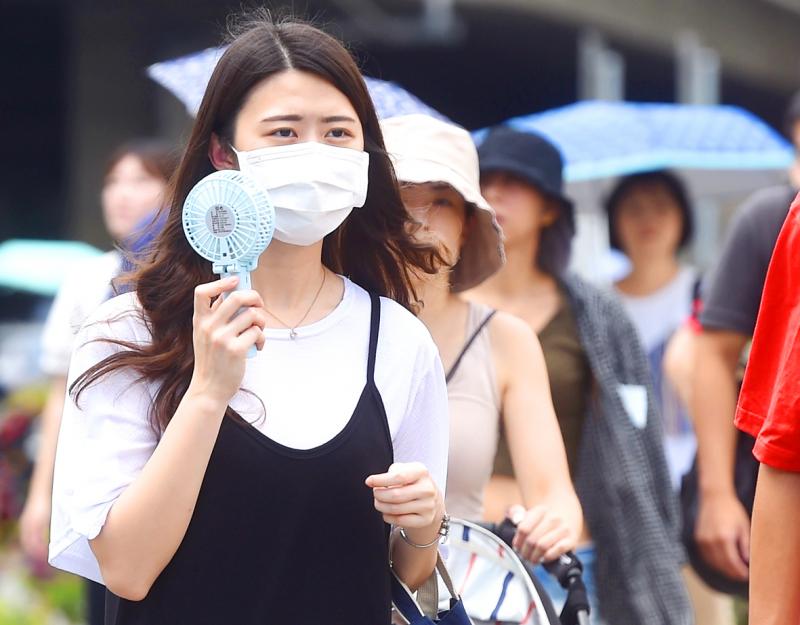The number of people seeking medical treatment for heat injury last month rose 40 percent to 653 from 467 a year earlier, the Health Promotion Administration (HPA) said yesterday.
Heat injuries include heatstroke, heat syncope, heat cramps, heat exhaustion, thermal fatigue and heat edema, it said.
HPA Community Health Division head Lo Su-ying (羅素英) said that people should drink water regularly when they are in warm environments, regardless of whether they are engaged in sports or other intense activities.

Photo: Chien Jung-fong, Taipei Times
They should not wait until they are thirsty to drink water, she said, adding that decreased urine output and darker urine color are signs of inadequate fluid intake.
People should also avoid drinking alcoholic beverages, Lo said.
People who work outdoors should monitor weather updates, she said, adding that they should avoid working at high noon.
Their work environment should be equipped with ventilators and shades, she said, adding that employers should arrange for workers to work in shifts when the weather is hot.
“Workers should wear light-colored, easy-fitting clothes made of breathable materials. They should wear sun-blocking and ventilating hats as well as sunglasses, and avoid direct exposure to the sun or hot stoves for long periods,” Lo said.
People with chronic diseases and elderly people should undergo health exams to see if they can work in environments with high temperature and humidity, Lo said.
They should also watch their use of medication, as taking diuretics, for example, would accelerate dehydration, she said.
“If they show signs of a heat injury, such as increased body temperature, dry and red skin, rapid heartbeat, headache, nausea, vomiting, delirium or cramps, they should immediately leave the high-temperature work environment and try to cool down by loosening their clothes and wiping their body with wet towels, Lo said.
“They should also drink slightly salted water or sports drinks. If there is still no sign of improvement, they should seek medical attention as soon as possible,” she said.
HPA Director-General Wang Ying-wei (王英偉) said that employers can consult the heat-injury prevention Web site built by the Occupational Safety and Health Administration under the Ministry of Labor to check the level of heat injury risk in their area.

‘WIN-WIN’: The Philippines, and central and eastern European countries are important potential drone cooperation partners, Minister of Foreign Affairs Lin Chia-lung said Minister of Foreign Affairs Lin Chia-lung (林佳龍) in an interview published yesterday confirmed that there are joint ventures between Taiwan and Poland in the drone industry. Lin made the remark in an exclusive interview with the Chinese-language Liberty Times (the Taipei Times’ sister paper). The government-backed Taiwan Excellence Drone International Business Opportunities Alliance and the Polish Chamber of Unmanned Systems on Wednesday last week signed a memorandum of understanding in Poland to develop a “non-China” supply chain for drones and work together on key technologies. Asked if Taiwan prioritized Poland among central and eastern European countries in drone collaboration, Lin

The US government has signed defense cooperation agreements with Japan and the Philippines to boost the deterrence capabilities of countries in the first island chain, a report by the National Security Bureau (NSB) showed. The main countries on the first island chain include the two nations and Taiwan. The bureau is to present the report at a meeting of the legislature’s Foreign Affairs and National Defense Committee tomorrow. The US military has deployed Typhon missile systems to Japan’s Yamaguchi Prefecture and Zambales province in the Philippines during their joint military exercises. It has also installed NMESIS anti-ship systems in Japan’s Okinawa

The Chien Feng IV (勁蜂, Mighty Hornet) loitering munition is on track to enter flight tests next month in connection with potential adoption by Taiwanese and US armed forces, a government source said yesterday. The kamikaze drone, which boasts a range of 1,000km, debuted at the Taipei Aerospace and Defense Technology Exhibition in September, the official said on condition of anonymity. The Chungshan Institute of Science and Technology and US-based Kratos Defense jointly developed the platform by leveraging the engine and airframe of the latter’s MQM-178 Firejet target drone, they said. The uncrewed aerial vehicle is designed to utilize an artificial intelligence computer

Renewed border fighting between Thailand and Cambodia showed no signs of abating yesterday, leaving hundreds of thousands of displaced people in both countries living in strained conditions as more flooded into temporary shelters. Reporters on the Thai side of the border heard sounds of outgoing, indirect fire yesterday. About 400,000 people have been evacuated from affected areas in Thailand and about 700 schools closed while fighting was ongoing in four border provinces, said Thai Rear Admiral Surasant Kongsiri, a spokesman for the military. Cambodia evacuated more than 127,000 villagers and closed hundreds of schools, the Thai Ministry of Defense said. Thailand’s military announced that